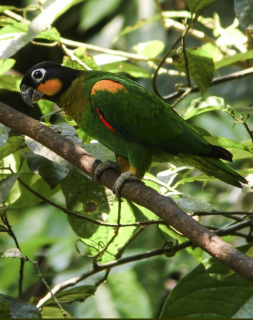Orange-cheeked Parrot |
|
|
Also known as: Barraband's Parrot
Photos
View in GalleryDid You Know?
The Orange-cheeked Parrot regularly visits clay banks (or licks) to consume the antacid-like soil which neutralizes toxins found in some of the foods they eat.Academic Research
Related publications: Pyrilia barrabandiSpecies Profile
Genus: Pyrilia | Species: barrabandi
Size:
25cm (9.75 in)
Weight:
165-190g (5.8-6.7 oz)
Subspecies including nominate:
two: P.b. barrabandi, P.b. aurantiigena
Colour Adult:
P.b. barrabandi: Both adults black head; orange/yellow cheeks; olive throat and breast; yellow thighs; orange/yellow bend of wing and lesser wing coverts; orange/red carpal edge and underwing coverts. Bill grey/black. Eye ring bare and white. Eye brown.
P.b. aurantiigena: Both adults deep orange cheeks, bend of wing, lesser wing coverts and thighs, with no yellow.
Colour Juvenile:
P.b. barrabandi: Brown crown; olive forehead, nape, cheeks and chin, with brown margin; green bend of wing and lesser wing coverts, with scattered yellow feathers; red carpal edge and underwing coverts with scattered green feathers.
Call:
Calls are reported as distinctive; in flight calls reedy and slurred. Alarm calls gutteral.
Listen NowVideo Links:
Video 1 | Video 2 | Video 3More Information:
Content Sources:
BirdLife International
Cornell Lab of Ornithology/Birds of the World
A Guide to Parrots of the World, Juniper and Parr, 1998
ML Media Collection Catalogue 82340, Orange-cheeked Parrot Pionopsitta barrabandi, Marantz, Curtis, Peru, Aug. 27 1994, Cornell Lab of Ornithology. Site
Parrots of the World, Forshaw, 2006. 2010 edition
Lexicon of Parrots, Thomas Arndt.
Photos
View in GalleryDid You Know?
The Orange-cheeked Parrot regularly visits clay banks (or licks) to consume the antacid-like soil which neutralizes toxins found in some of the foods they eat.Academic Research
Related publications: Pyrilia barrabandiSpecies Care
Captive Status:
Probably not kept outside Brazil.
Longevity:
Not recorded.
Housing:
Enclosure or aviary at least 3 x 2 x 2m (9.8 x 6.5 x 6.5 ft), minimum temperature 20C (68F).
Diet:
Fruit such as: apple, pear, oranges, in particular exotic fruits such as mango and papaya; vegetables such as: carrot, celery, peas in the pod if taken; lory or baby (lactose-free) food; seed mix such as: millet, canary, safflower, oats, a little hemp, limited sunflower seed; vitamin supplements, in particular, C.
Enrichment:
Provide bathing bowls or mist regularly; provide non-toxic, unsprayed flowering branches for chewing.
Nest Box Size:
Vertical box 10" x 10" x 24" (25.4cm x 25.4cm x 61cm).
Clutch Size:
Not recorded.
Incubation Time:
Not recorded.
Fledging Age:
Not recorded.
Hatch Weight:
Not recorded.
Peak Weight:
Not recorded.
Weaning Weight:
Not recorded.
Photos
View in GalleryDid You Know?
The Orange-cheeked Parrot regularly visits clay banks (or licks) to consume the antacid-like soil which neutralizes toxins found in some of the foods they eat.Academic Research
Related publications: Pyrilia barrabandiSpecies Wild Status
World Population:
Unknown, decreasing.
IUCN Red List Status:
Least Concern
CITES Listing:
Appendix II
Threat Summary:
Not globally threatened. Generally uncommon and local, but occasionally frequent to numerous in W parts of range. Loss of forest cover is not accelerating as quickly as once thought; range is still mostly intact. It may be vulnerable to hunting and persecution.
Range:
P.b. barrabandi: North of upper Amazon River from E Amazonas, N Brazil and S Venezuela to SE Colombia, E Ecuador and NE Peru.
P.b. aurantiigena: South of upper Amazon River from N Brazil to E Peru and N Bolivia.
Habitat:
Found up to 400m (1312 ft) in lowland terra firme forest, also less often in varzea stands. Also found at forest edge and in partly disturbed forest.
Wild Diet:
Diet includes seeds and fruits of Ficus, Pourouma and Pseudolmedia; two leguminous plants Mimosa and Pithecellobium, and one Olacaceae Heisteria. Also takes Ficus sphenophylla and another with larger fruit. Has been seen biting leaf galls on Pithecellobium trees, likely for wasp larvae. Recorded foraging for flowers.
Ecology and Behaviour:
Active early morning. Seen singly, in pairs and in small groups up to 10 and more at clay banks. Forages high in canopy or just below.
Clutch and Egg Size:
Not recorded.
Breeding Season:
Possibly September-October.
Related Links:
Photos
View in GalleryDid You Know?
The Orange-cheeked Parrot regularly visits clay banks (or licks) to consume the antacid-like soil which neutralizes toxins found in some of the foods they eat.Academic Research
Related publications: Pyrilia barrabandiMembers Only Resources
Please log-in now to find more research, resources and tools.
Not a Member?
Find more great information:
Gain exclusive access to 600+ pages of additional research, seminars and podcasts, specialists to ask your toughest questions, and dozens of other fun resources - when you become a WPT member.
Join Today >>

































